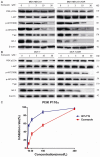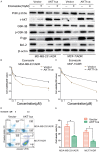Econazole nitrate reversed the resistance of breast cancer cells to Adriamycin through inhibiting the PI3K/AKT signaling pathway
- PMID: 32064166
- PMCID: PMC7017736
Econazole nitrate reversed the resistance of breast cancer cells to Adriamycin through inhibiting the PI3K/AKT signaling pathway
Erratum in
-
Erratum: Econazole nitrate reversed the resistance of breast cancer cells to Adriamycin through inhibiting the PI3K/AKT signaling pathway.Am J Cancer Res. 2022 Jul 15;12(7):3486-3490. eCollection 2022. Am J Cancer Res. 2022. PMID: 35968323 Free PMC article.
Abstract
Activation of the phosphoinositide 3 kinase (PI3K)/AKT pathway is frequently implicated in resistance to anticancer therapies. PI3K inhibitors can restore sensitivity to standard breast cancer therapies, including endocrine therapy, HER2-targeted agents, and chemotherapy. Our previous research showed that econazole, a novel PI3Ka inhibitor, inhibits the PI3K/AKT pathway and induces apoptosis in lung cancer cells. In this study, econazole showed significant cytotoxic activity against Adriamycin-resistant breast cancer cells in vitro and in vivo. Additionally, econazole significantly sensitized MDA-MB-231 and MCF-7 cells to Adriamycin via inhibiting the PI3K/AKT pathway. Overexpression of constitutively active AKT1 abolished the function of econazole. The combination of econazole and Adriamycin exerted synergistic inhibitory effects in breast cancer cells in vitro and in vivo. Taken together, the PI3K inhibitor econazole could effectively overcome Adriamycin resistance and showed synergistic effects with chemotherapy on breast cancer.
Keywords: AKT; Adriamycin; Econazole; PI3K; breast cancer; drug resistance.
AJCR Copyright © 2020.
Conflict of interest statement
None.
Figures





References
-
- Sun WL, Lan D, Gan TQ, Cai ZW. Autophagy facilitates multidrug resistance development through inhibition of apoptosis in breast cancer cells. Neoplasma. 2015;62:199–208. - PubMed
-
- Hu Y, Li C, Li H, Li M, Shu X. Resveratrol-mediated reversal of tumor multi-drug resistance. Curr Drug Metab. 2014;15:703–710. - PubMed
-
- Abraham J. PI3K/AKT/mTOR pathway inhibitors: the ideal combination partners for breast cancer therapies? Expert Rev Anticancer Ther. 2015;15:51–68. - PubMed
-
- Han Z, Hong L, Han Y, Wu K, Han S, Shen H, Li C, Yao L, Qiao T, Fan D. Phospho Akt mediates multidrug resistance of gastric cancer cells through regulation of P-gp, Bcl-2 and Bax. J Exp Clin Cancer Res. 2007;26:261–268. - PubMed
LinkOut - more resources
Full Text Sources
Research Materials
Miscellaneous
